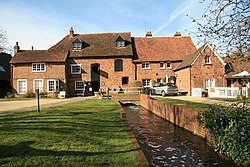
Hatfield is a town and civil parish in Hertfordshire, England, in the borough of Welwyn Hatfield. It had a population of 29,616 in 2001, 39,201 at the 2011 Census, and 41,265 at the 2021 Census. The settlement is of Saxon origin. Hatfield House, home of the Marquess of Salisbury, forms the nucleus of the old town. From the 1930s when de Havilland opened a factory, until the 1990s when British Aerospace closed it, aircraft design and manufacture employed more people there than any other industry. Hatfield was one of the post-war New Towns built around London and has much modernist architecture from the period. The University of Hertfordshire is based there.

Hertfordshire is a ceremonial county in the East of England and one of the home counties. It borders Bedfordshire to the north-west, Cambridgeshire to the north-east, Essex to the east, Greater London to the south and Buckinghamshire to the west. The largest settlement is Watford, and the county town is Hertford.

Welwyn Hatfield is a local government district with borough status in the county of Hertfordshire, England. Its council is based in Welwyn Garden City. The borough borders Hertsmere, St Albans, North Hertfordshire, East Hertfordshire, Broxbourne, and the London Borough of Enfield.

Welwyn Garden City is a town in Hertfordshire, England, 20 miles (32 km) north of London. It was the second garden city in England and one of the first new towns. It is unique in being both a garden city and a new town and exemplifies the physical, social and cultural planning ideals of the periods in which it was built.
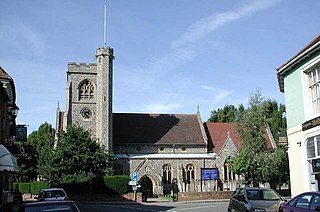
Welwyn is a village and civil parish in Hertfordshire, England. The parish also includes the villages of Digswell and Oaklands. It is sometimes referred to as Old Welwyn or Welwyn Village, to distinguish it from the much newer and larger settlement of Welwyn Garden City, about a mile to the south.
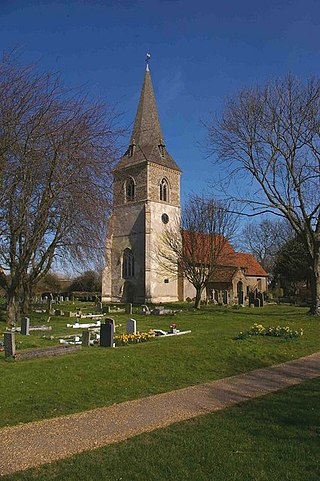
Datchworth is a village and civil parish between the towns of Hertford, Stevenage and Welwyn Garden City in the county of Hertfordshire, England. Sited on the Roman road from St Albans to Puckeridge, the village has examples of Saxon clearings in several locations. Datchworth has a village green where there are two pubs and a sports club. In the 2001 Census the population was 1,065, increasing to 1,524 at the 2011 Census.

Little Hallingbury is a small village and a civil parish in the Uttlesford district of Essex, England.

Brocket Hall is a neo-classical country house set in a large park at the western side of the urban area of Welwyn Garden City in Hertfordshire, England. The estate is equipped with two golf courses and seven smaller listed buildings, apart from the main house. The freehold on the estate is held by the 3rd Baron Brocket. The house is Grade I-listed.
Oaklands College is a further education college in Hertfordshire, United Kingdom. It was established in 1991 when further education was reorganised. The college has campuses in St Albans and Welwyn Garden City, with a further provision in Borehamwood. Over 10,000 students study at the college annually, studying full time, part time and higher education courses as well as apprenticeships.
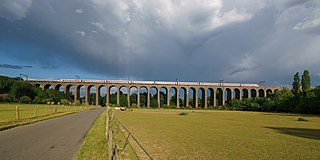
The Digswell Viaduct, also called Welwyn Viaduct, is a railway viaduct that carries the East Coast Main Line over the River Mimram in the county of Hertfordshire in England. A prominent local landmark, it is located between Welwyn Garden City and Digswell. It is just to the south of Welwyn North railway station.

Lemsford is a village in Hertfordshire, England. It is located close to Welwyn Garden City and Hatfield and is in the Hatfield Villages Ward of the Borough of Welwyn Hatfield.

The Welwyn Roman Baths are a Roman ruin preserved under the A1(M) just north of modern-day Welwyn Garden City, Hertfordshire, England. The baths were a small part of the Dicket Mead villa, which was originally built in the 3rd century AD.

Hertingfordbury is a small village in Hertfordshire, England, close to the county town of Hertford. It was mentioned in the Domesday Book of 1086. Hertingfordbury is also the name of a neighbouring civil parish, which does not contain the village. Hertingfordbury village is within the Castle ward of Hertford Town Council. The population of the civil parish as of the 2021 census was 689.

The county of Hertfordshire is divided into ten districts. The districts of Hertfordshire are Three Rivers, Watford, Hertsmere, Welwyn Hatfield, Broxbourne, East Hertfordshire, Stevenage, North Hertfordshire, St Albans, and Dacorum.

The Chequers was a public house which occupied a Grade II listed building in Potters Bar, England. Originally opening in the 1700s, the pub moved site across the road and opened in its current location in the 1840s. Although there is no consensus as to when the current building was originally constructed, it started as two separate houses which were joined together before the pub moved onto the site.
National Cycle Route 61 is part of the National Cycle Network managed by the charity Sustrans. It runs for 34 miles from Maidenhead (Berkshire) to Rye House (Hertfordshire) via Uxbridge, Watford, St Albans, Hatfield, Welwyn Garden City and Hertford in the United Kingdom.

St. Mary's Church is a Church of England church located in Welwyn, Hertfordshire, in the United Kingdom. It is north of the River Mimram and within the Welwyn conservation area. The present church building is a grade II listed building.
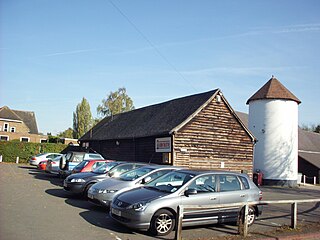
The Barn Theatre, located in Welwyn Garden City, England is a Grade II listed, 17th-century timber-framed barn converted to a community theatre in 1931.

The Nabisco Shredded Wheat Factory is a disused factory which formerly produced variants of the shredded wheat breakfast cereal in Welwyn Garden City, in the United Kingdom. It was designed by architect Louis de Soissons to encourage companies to establish factories in the industrial areas of garden cities. The design of the Welwyn Garden City factory was inspired by an existing one in Niagara Falls, USA, also operated by the Shredded Wheat Company of America. Two buildings were operational at the time of its opening: a southern grain silo complex of 18 silos, and a western three–storey production area. Further expansions to the factory took place in the 1930s and 1950s with the construction of 27 additional silos, a new production area, and office space.
